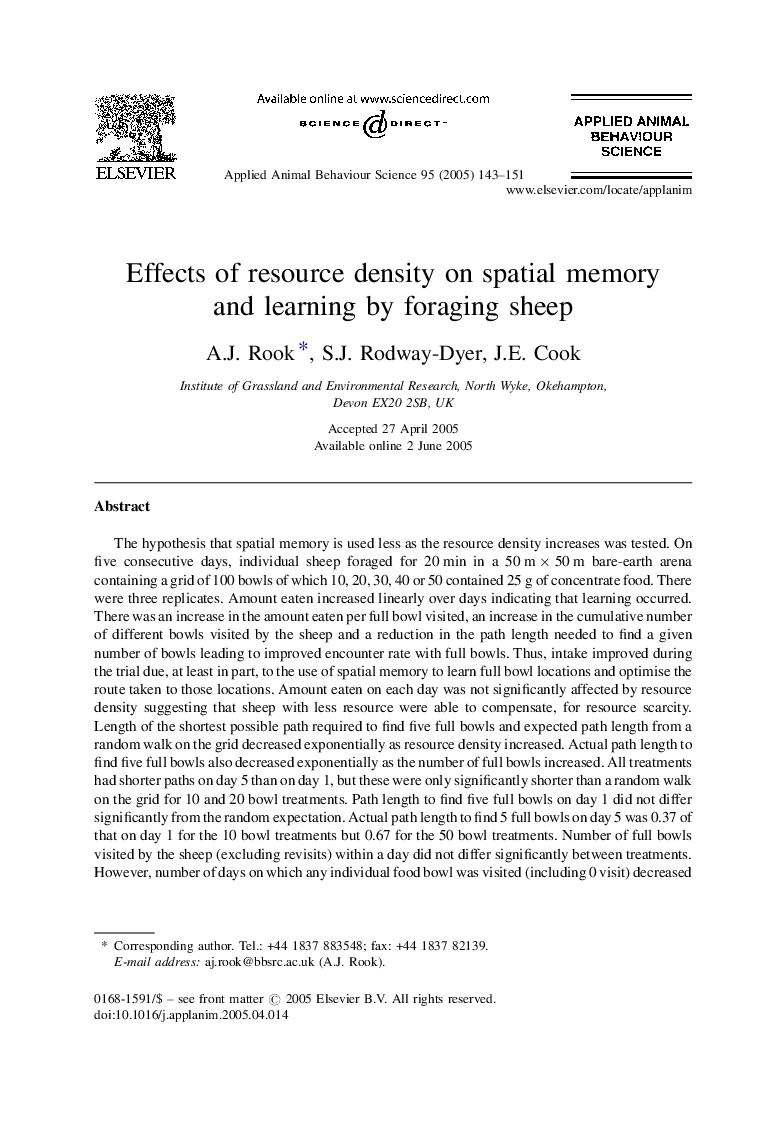| کد مقاله | کد نشریه | سال انتشار | مقاله انگلیسی | نسخه تمام متن |
|---|---|---|---|---|
| 9475827 | 1625450 | 2005 | 9 صفحه PDF | دانلود رایگان |
عنوان انگلیسی مقاله ISI
Effects of resource density on spatial memory and learning by foraging sheep
دانلود مقاله + سفارش ترجمه
دانلود مقاله ISI انگلیسی
رایگان برای ایرانیان
کلمات کلیدی
موضوعات مرتبط
علوم زیستی و بیوفناوری
علوم کشاورزی و بیولوژیک
علوم دامی و جانورشناسی
پیش نمایش صفحه اول مقاله

چکیده انگلیسی
The hypothesis that spatial memory is used less as the resource density increases was tested. On five consecutive days, individual sheep foraged for 20 min in a 50 m Ã 50 m bare-earth arena containing a grid of 100 bowls of which 10, 20, 30, 40 or 50 contained 25 g of concentrate food. There were three replicates. Amount eaten increased linearly over days indicating that learning occurred. There was an increase in the amount eaten per full bowl visited, an increase in the cumulative number of different bowls visited by the sheep and a reduction in the path length needed to find a given number of bowls leading to improved encounter rate with full bowls. Thus, intake improved during the trial due, at least in part, to the use of spatial memory to learn full bowl locations and optimise the route taken to those locations. Amount eaten on each day was not significantly affected by resource density suggesting that sheep with less resource were able to compensate, for resource scarcity. Length of the shortest possible path required to find five full bowls and expected path length from a random walk on the grid decreased exponentially as resource density increased. Actual path length to find five full bowls also decreased exponentially as the number of full bowls increased. All treatments had shorter paths on day 5 than on day 1, but these were only significantly shorter than a random walk on the grid for 10 and 20 bowl treatments. Path length to find five full bowls on day 1 did not differ significantly from the random expectation. Actual path length to find 5 full bowls on day 5 was 0.37 of that on day 1 for the 10 bowl treatments but 0.67 for the 50 bowl treatments. Number of full bowls visited by the sheep (excluding revisits) within a day did not differ significantly between treatments. However, number of days on which any individual food bowl was visited (including 0 visit) decreased linearly as resource density increased. The proportion of full bowls visited that were revisited on the same day was significantly higher for the 10 bowl treatments. These results suggest that sheep used spatial memory to optimise their route to food bowls more effectively at lower resource density.
ناشر
Database: Elsevier - ScienceDirect (ساینس دایرکت)
Journal: Applied Animal Behaviour Science - Volume 95, Issues 3â4, December 2005, Pages 143-151
Journal: Applied Animal Behaviour Science - Volume 95, Issues 3â4, December 2005, Pages 143-151
نویسندگان
A.J. Rook, S.J. Rodway-Dyer, J.E. Cook,